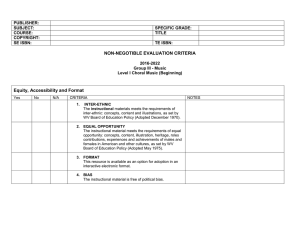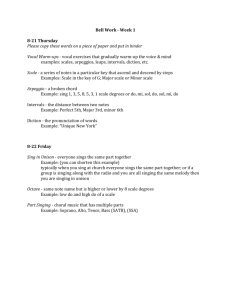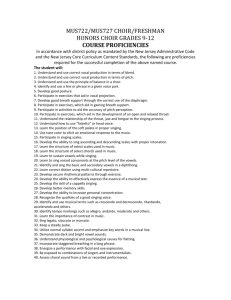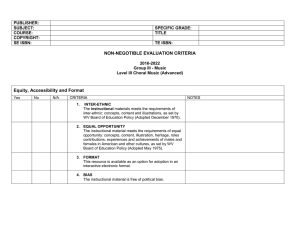NON-NEGOTIBLE EVALUATION CRITERIA
advertisement
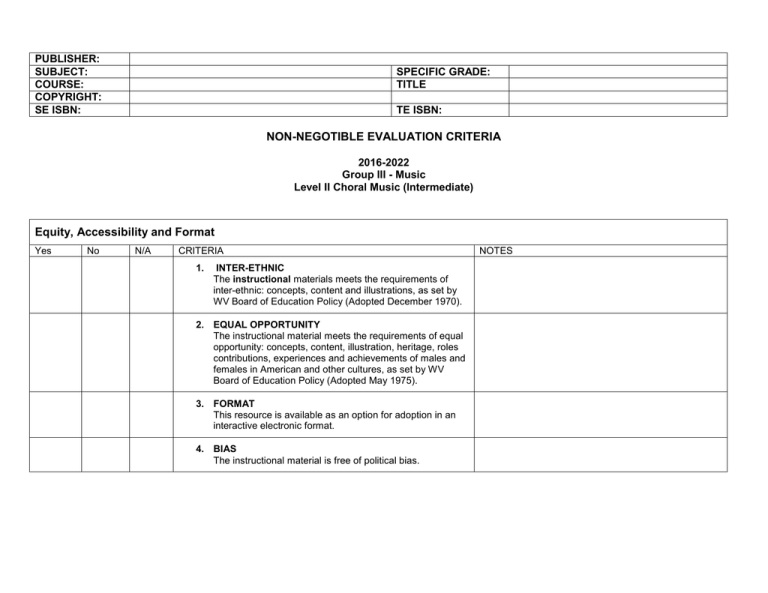
PUBLISHER: SUBJECT: COURSE: COPYRIGHT: SE ISBN: SPECIFIC GRADE: TITLE TE ISBN: NON-NEGOTIBLE EVALUATION CRITERIA 2016-2022 Group III - Music Level II Choral Music (Intermediate) Equity, Accessibility and Format Yes No N/A CRITERIA 1. INTER-ETHNIC The instructional materials meets the requirements of inter-ethnic: concepts, content and illustrations, as set by WV Board of Education Policy (Adopted December 1970). 2. EQUAL OPPORTUNITY The instructional material meets the requirements of equal opportunity: concepts, content, illustration, heritage, roles contributions, experiences and achievements of males and females in American and other cultures, as set by WV Board of Education Policy (Adopted May 1975). 3. FORMAT This resource is available as an option for adoption in an interactive electronic format. 4. BIAS The instructional material is free of political bias. NOTES GENERAL EVALUATION CRITERIA 2016-2022 Group III - Music Level II Choral Music (Intermeidate) The general evaluation criteria apply to each grade level and are to be evaluated for each grade level unless otherwise specified. These criteria consist of information critical to the development of all grade levels. In reading the general evaluation criteria and subsequent specific grade level criteria, e.g. means “examples of” and i.e. means that “each of” those items must be addressed. Eighty percent of the general and eighty percent of the specific criteria must be met with I (in-depth) or A (adequate) in order to be recommended. (Vendor/Publisher) SPECIFIC LOCATION OF CONTENT WITHIN PRODUCTS (IMR Committee) Responses I=In-depth, A=Adequate, M=Minimal, N=Nonexistent I A M N In addition to alignment of Content Standards and Objectives (CSOs), materials must also clearly connect to Learning for the 21st Century which includes opportunities for students to develop: 21st Century Music Education Content Standards and Objections Policy 2520.10: Performing (Performing, Presenting, Producing) The instructional materials will: 1. support student understanding through inquiry-based learning that builds on prior knowledge and experiences of singing along and/or with others. 2. support student understanding through inquiry-based learning that builds on prior knowledge and experience of performing on instruments, along and with others. 3. provide supplemental materials of a varied repertoire of music. Thinking and Problem-Solving Skills (Exploring) The instructional materials will: 4. foster complex analysis of content that is presented in a variety of mediums; promote development of mental perspectives; develop lifelong curiosity about the arts; and/or reference the historical influences of the arts. 5. present standard rhythmic and melodic notation in a developmentally appropriate sequence. 6. use global connections to expand musical experiences. 7. support personalized learning through developmentally appropriate materials and content, including enrichment activities. 8. provide a music theory component. Creating The instructional materials will: 9. provide multiple and varied instructional materials for improvisation and composition to utilize different medium (i.e., instrumental, vocal, and electronic music) at all levels. 10. provide varied and multiple movement-based activities. Developmentally Appropriate Instructional Resources and Strategies: For student mastery of content standards and objectives, the instructional materials will: 11. offer interdisciplinary connections. 12. provide resources to connect the social, political, cultural and economic contexts of works of art while maintaining in-depth focus on each work. 13. provide multiple and varied resources for the study of art careers to increase arts literacy across disciplines. 14. provide multiple and varied resources to study works of art. Assessment / Interpersonal and Self-Direction Skills The instructional materials will: 15. provide tools for assessment to include diagnostic and formative and summative assessments. These assessments will be presented in multiple formats (i.e., rubrics, text-dependent questions, performance tasks, open-ended questions, portfolio evaluation, and multimedia simulations). 16. provide opportunity for student self-assessments. 17. provide teachers with tools to develop student self-assessments. Organization, Presentation, and Format The instructional materials will: 18. offer a variety of visual aids including graphic organizers, graphs, charts, and listening guides. 19. provide interactive resource(s) (i.e., website, app, DVD, CD, interactive white boards). 20. support differentiated instruction. 21. present materials in developmental scope and sequence. 22. include text-based questions and performance tasks that address and support music terminology and music literacy. Personal and Workplace Productivity Skills Instructional materials will provide students with opportunity to: 23. conduct research, validate source and report ethically on findings. 24. identify, evaluate, and apply appropriate technology tools for a variety of purposes. 25. work collaboratively. 26. engage in self-directed inquiry. 27. practice time-management and project management skills. SPECIFIC EVALUATION CRITERIA 2016-2022 Group III - Music Level II Choral Music (Intermediate) The Intermediate Choral Music objectives are written for students who have advanced past the beginning study of voice. Typically these students would be at the late middle school level or high school level, but the class may include more advanced elementary or early middle school students who have not progressed to the Advanced level. Students at the Intermediate level build on previously studied skills, learning additional choral techniques and more developed singing styles. They further develop their singing range, ensemble singing, sight-reading and self-evaluation skills. WV Standard 1: Performing Singing, playing, and moving are fundamental processes of musical expression. Basic performing skills in singing and in playing a variety of pitched and nonpitched instruments are developed in the K-8 general music area of study. Students who participate in the concentrated study of choral and/or instrumental music area of study will develop advanced musical skills and technical accuracy through a varied repertoire of musical literature. Piano and fold music areas of study may also be taught at the high school level. WV Standard 2: Exploring Skills in the analysis of music enables students to listen to a wide variety of music with discernment and enjoyment. Broad experiences with a variety of music assist students in evaluating musical works and performances. The ability to read and notate music is the foundation for independent study and performance. Exploring musical notation is a key to lifelong learning and participation in music. Music reading experiences begin in kindergarten and are stressed through all levels of study. WV Standard 3: Creating Creating music by improvisation and composition is encouraged and developed through experiences in music. Students at the secondary level may further develop improvisation and composition skills through participation in small ensembles and classes in music theory or composition. WV Standard 4: Relating Students will be encouraged to explore the commonalities and relationship between music and other disciplines. As it becomes easier to maneuver around our world, students must become more diverse in their knowledge of history, other cultures and the importance of music as it pertains to these. In an increasingly independent world, students must develop awareness of diversity in cultures and the uniqueness of music to cultures. For student mastery of content standards and objectives, the instructional materials will provide students with the opportunity to (Vendor/Publisher) SPECIFIC LOCATION OF CONTENT WITHIN PRODUCTS (IMR Committee) Responses I=In-depth, A=Adequate, M=Minimal, N=Nonexistent Performing 1. sing a variety of music with more than one voice part. 2. sing a variety of choral literature, e.g., regional, national, global. 3. expand use of metric accents, e.g., accent marks, tenuto. 4. sing major and minor melodies. 5. sing songs in a variety of global languages. 6. refine attacks and releases. 7. sing with expression that is consistent with the interpretation of the text. 8. sing intervals with good intonation, balance and blend. 9. demonstrate dark and bright vowel sounds. 10. refine, apply and build vocal technique through warm-ups and a variety of vocal literature. 11. sing a cappella music. 12. refine characteristics of ensemble singing, e.g., balance, blend and styles. 13. sing music containing constrasting dynamic levels. 14. sing literature with varied rhythmic patterns. 15. match pitch with good intonation. I A M N 16. sing repertoire to include a variety of tempi and meter changes. 17. develops accountability and personal productivity through practice habits. Exploring 1. expand singing and exploration of various meters and tempo markings. 2. explain and explore major and minor tonalities. 3. identify and sing intervals from notation, e.g., major, minor, perfect. 4. read and sing melodies containing syncopation. 5. identify and vocally apply musical terms, expression marks and symbols. 6. identify the melodic and harmonic parts in a vocal piece. 7. sing from a choral score observing standard notation. 8. sight sing simple melodies. 9. identify musical phrases and forms. 10. discuss differences in singing various styles of music. 11. identify criteria for an outstanding performance. 12. evaluate live and recorded performances of themselves and others. 13. identify conducting patterns and gestures. 14. review and refine previously learned rhythms. 15. identify sixteenth notes and dotted rhythms. Creating 1. improvise rhythmic and melodic variations on a given melodic phrase. 2. create lyrics for a multi-section song, e.g., AB, ABA. 3. compose a vocal warm-up. Relating 1. use information and communication technology to examine musical careers. 2. discuss the historical and global origins of a choral work. 3. discuss the anatomy of the human voice and how it affects vocal tone production. 4. discuss and demonstrate social responsibility through appropriate audience behavior. 5. discuss the literary merits of choral texts.
